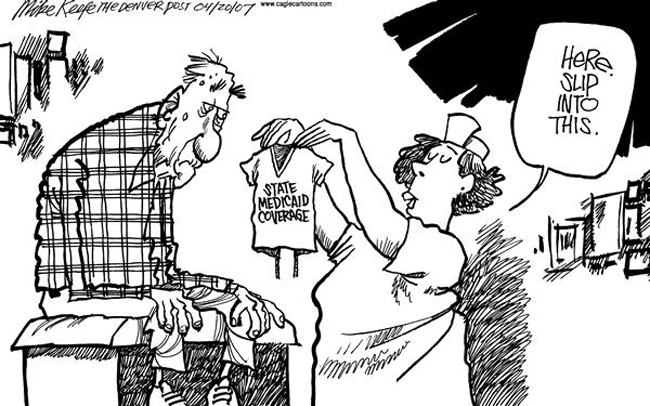 States face a tough choice right now, of whether to expand their Medicaid roles with 90% of the costs being borne by the government. (Medicaid is a combined Federal/State program to pay for healthcare of low income individuals and families.) Why is taking money from the Feds a tough decision?
States face a tough choice right now, of whether to expand their Medicaid roles with 90% of the costs being borne by the government. (Medicaid is a combined Federal/State program to pay for healthcare of low income individuals and families.) Why is taking money from the Feds a tough decision?
For starters, it means supporting, gulp, “Obamacare”. Republican governors who expand Medicaid, in accord with that law, will look like they are supporting that guy who so many of their supporters believe is a Kenyan socialist.
To make matters more complicated, many business interests (especially hospitals) are urging Republicans to support Medicaid expansion. Without this expansion, they know they will have fewer paying customers.
Politics and business aside, one other fact makes this a tough call: Even 10% of an expensive expansion is a lot of money. Here is an excerpt from a recent USA Today article, explaining the dilemma:
Though states could reap a large return from expanded Medicaid benefits, the extra costs are a challenge, said Michael Morrissey, a University of Alabama health care economist.
A recent study by Morrissey found that Medicaid expansion in Alabama would generate almost $20 billion in new income from 2014 to 2020 and $1.7 billion in extra taxes to local government. That assumed that 60% of the uninsured would get insurance. To get those benefits, Alabama taxpayers would have to come up with $771 million in new revenue to pay to administer the expansion, he said.
What do you think? Can States afford this? Should they find a way to afford this? Is it time, as I’ve urged before, to nationalize Medicaid?
(Click here to view comments)

 Andrews was easily the most anxious patient I took care of that month, a gray Michigan February (is there any other kind?) which I spent in the hospital caring for patients admitted to the general medical ward at the Ann Arbor Veterans Affairs Medical Center. (Andrews is a pseudonym, as are all the patients I blog about, unless otherwise indicated.) He had plenty to be anxious about, too. His leukemia was raging out of control, his blood looking like pus, teeming as it was with malignant white blood cells. At his age—he was almost 60—and after a decade of chronic bone marrow cancer, his disease was especially dangerous. Odds were high he would survive for less than a year.
Andrews was easily the most anxious patient I took care of that month, a gray Michigan February (is there any other kind?) which I spent in the hospital caring for patients admitted to the general medical ward at the Ann Arbor Veterans Affairs Medical Center. (Andrews is a pseudonym, as are all the patients I blog about, unless otherwise indicated.) He had plenty to be anxious about, too. His leukemia was raging out of control, his blood looking like pus, teeming as it was with malignant white blood cells. At his age—he was almost 60—and after a decade of chronic bone marrow cancer, his disease was especially dangerous. Odds were high he would survive for less than a year. The first test tube baby was born July 25th, 1978 in the north of England. Louise Brown was called the “baby of the century” by some and a “moral abomination” by others. It wasn’t Brown who critics accused of being immoral, of course. She was just a blameless infant. Instead, it was her doctors who came under fire for their new fertility treatment—in vitro fertilization (or IVF). Roman Catholic theologians characterized this treatment as “unnatural”. Bioethicists fretted about the risk such treatments posed for mothers and children.
The first test tube baby was born July 25th, 1978 in the north of England. Louise Brown was called the “baby of the century” by some and a “moral abomination” by others. It wasn’t Brown who critics accused of being immoral, of course. She was just a blameless infant. Instead, it was her doctors who came under fire for their new fertility treatment—in vitro fertilization (or IVF). Roman Catholic theologians characterized this treatment as “unnatural”. Bioethicists fretted about the risk such treatments posed for mothers and children. In two recent posts, I have posed questions about the appropriateness or inappropriateness of manipulating consumers by taking advantage of behavioral phenomena beyond their awareness. We behavioral scientists know things about human nature that most people haven’t learned. That is why we can fill books with visual illusions – our understanding of how the brain processes visual data allows us to play tricks on people. Indeed, this idea of visual illusions influenced the thinking of early behavioral economists and psychologists, who uncovered what they called “cognitive illusions.” (Daniel Kahneman discusses this topic in his book Thinking Fast and Slow.)
In two recent posts, I have posed questions about the appropriateness or inappropriateness of manipulating consumers by taking advantage of behavioral phenomena beyond their awareness. We behavioral scientists know things about human nature that most people haven’t learned. That is why we can fill books with visual illusions – our understanding of how the brain processes visual data allows us to play tricks on people. Indeed, this idea of visual illusions influenced the thinking of early behavioral economists and psychologists, who uncovered what they called “cognitive illusions.” (Daniel Kahneman discusses this topic in his book Thinking Fast and Slow.)
 Watch this segment
Watch this segment